Book
ISBN: 0934613117 9780934613118 Year: 1986 Publisher: San Mateo, CA : Morgan Kaufmann Publishers,
Abstract | Keywords | Export | Availability | Bookmark
 Loading...
Loading...Choose an application
- Reference Manager
- EndNote
- RefWorks (Direct export to RefWorks)
Mathematical linguistics --- Artificial intelligence. Robotics. Simulation. Graphics --- Computational linguistics --- Linguistique informatique --- Natural language processing (Computer science) --- 681.3*I27 --- NLP (Computer science) --- Artificial intelligence --- Electronic data processing --- Human-computer interaction --- Semantic computing --- Natural language processing: language generation; language models; language parsing and understanding; machine translation; speech recognition and under-standing; text analysis (Artificial intelligence) --- 681.3*I27 Natural language processing: language generation; language models; language parsing and understanding; machine translation; speech recognition and under-standing; text analysis (Artificial intelligence) --- Computational linguistics.
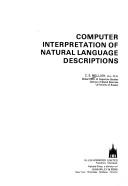
ISBN: 0853128286 Year: 1985 Publisher: Chichester : New York, NY : Ellis Horwood, Halsted Press,
Abstract | Keywords | Export | Availability | Bookmark
 Loading...
Loading...Choose an application
- Reference Manager
- EndNote
- RefWorks (Direct export to RefWorks)
Lexicology. Semantics --- Mathematical linguistics --- Artificial intelligence. Robotics. Simulation. Graphics --- Natural language processing (Computer science) --- 681.3*I27 --- NLP (Computer science) --- Artificial intelligence --- Electronic data processing --- Human-computer interaction --- Semantic computing --- Natural language processing: language generation; language models; language parsing and understanding; machine translation; speech recognition and under-standing; text analysis (Artificial intelligence) --- 681.3*I27 Natural language processing: language generation; language models; language parsing and understanding; machine translation; speech recognition and under-standing; text analysis (Artificial intelligence) --- Computational linguistics.
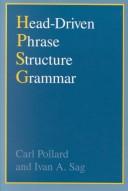
ISBN: 0226674479 0226674460 9780226674476 Year: 1994 Publisher: Stanford, CA : Chicago (Ill.) ; London : Center for the study of language and information ; The University of Chicago Press,
Abstract | Keywords | Export | Availability | Bookmark
 Loading...
Loading...Choose an application
- Reference Manager
- EndNote
- RefWorks (Direct export to RefWorks)
This book presents the most complete exposition of the theory of head-driven phrase structure grammar (HPSG), introduced in the authors' Information-Based Syntax and Semantics. HPSG provides an integration of key ideas from the various disciplines of cognitive science, drawing on results from diverse approaches to syntactic theory, situation semantics, data type theory, and knowledge representation. The result is a conception of grammar as a set of declarative and order-independent constraints, a conception well suited to modelling human language processing. This self-contained volume demonstrates the applicability of the HPSG approach to a wide range of empirical problems, including a number which have occupied center-stage within syntactic theory for well over twenty years: the control of "understood" subjects, long-distance dependencies conventionally treated in terms of wh-movement, and syntactic constraints on the relationship between various kinds of pronouns and their antecedents. The authors make clear how their approach compares with and improves upon approaches undertaken in other frameworks, including in particular the government-binding theory of Noam Chomsky.
Mathematical linguistics --- Head-driven phrase structure grammar. --- 681.3*I27 --- Natural language processing: language generation; language models; language parsing and understanding; machine translation; speech recognition and under-standing; text analysis (Artificial intelligence) --- 681.3*I27 Natural language processing: language generation; language models; language parsing and understanding; machine translation; speech recognition and under-standing; text analysis (Artificial intelligence) --- Head-driven phrase structure grammar --- HPSG (Linguistics) --- Phrase structure grammar --- Formalisation (linguistique) --- Grammaire de constituants
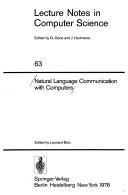
ISBN: 354008911X 038708911X 3540357653 9780387089119 9783540089117 Year: 1978 Volume: 63 Publisher: Berlin : Springer-Verlag,
Abstract | Keywords | Export | Availability | Bookmark
 Loading...
Loading...Choose an application
- Reference Manager
- EndNote
- RefWorks (Direct export to RefWorks)
Artificial intelligence. Robotics. Simulation. Graphics --- 681.3*A0 --- 681.3*I27 --- General --- Natural language processing: language generation; language models; language parsing and understanding; machine translation; speech recognition and under-standing; text analysis (Artificial intelligence) --- 681.3*I27 Natural language processing: language generation; language models; language parsing and understanding; machine translation; speech recognition and under-standing; text analysis (Artificial intelligence) --- 681.3*A0 General --- Computer science. --- Personal Computing. --- Programming Languages, Compilers, Interpreters. --- Informatics --- Science --- Langages de programmation --- Programmation système (informatique)
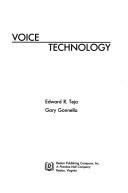
ISBN: 0835984176 Year: 1983 Publisher: Englewood Cliffs, NJ : Prentice-Hall International,
Abstract | Keywords | Export | Availability | Bookmark
 Loading...
Loading...Choose an application
- Reference Manager
- EndNote
- RefWorks (Direct export to RefWorks)
Speech processing systems --- 681.3*B0 --- 681.3*I27 --- Computational linguistics --- Electronic systems --- Information theory --- Modulation theory --- Oral communication --- Speech --- Telecommunication --- Computerwetenschap--?*B0 --- Natural language processing: language generation; language models; language parsing and understanding; machine translation; speech recognition and under-standing; text analysis (Artificial intelligence) --- 681.3*I27 Natural language processing: language generation; language models; language parsing and understanding; machine translation; speech recognition and under-standing; text analysis (Artificial intelligence) --- Singing voice synthesizers --- Speech processing systems. --- Parole (Systèmes de traitement de la). --- Spraakverwerkingssystemen.
Dissertation
ISBN: 9056821504 Year: 1998 Publisher: Heverlee Katholieke Universiteit Leuven. Faculteit der Toegepaste Wetenschappen. Departement Elektrotechniek
Abstract | Keywords | Export | Availability | Bookmark
 Loading...
Loading...Choose an application
- Reference Manager
- EndNote
- RefWorks (Direct export to RefWorks)
Proefschriften --- Thèses --- Academic collection --- 681.5.017 --- #BIBC:T1998 --- 681.3*I27 --- Simulation (control systems) --- Natural language processing: language generation; language models; language parsing and understanding; machine translation; speech recognition and under-standing; text analysis (Artificial intelligence) --- Theses --- 681.3*I27 Natural language processing: language generation; language models; language parsing and understanding; machine translation; speech recognition and under-standing; text analysis (Artificial intelligence) --- 681.5.017 Simulation (control systems)
Dissertation
ISBN: 9789056828141 Year: 2007 Publisher: Leuven Katholieke Universiteit Leuven
Abstract | Keywords | Export | Availability | Bookmark
 Loading...
Loading...Choose an application
- Reference Manager
- EndNote
- RefWorks (Direct export to RefWorks)
De voorbije 25 jaar werd het onderzoek naar automatische spraakherkenning gedomineerd door systemen gebaseerd op verborgen Markov ketens (HMMs). In deze dissertatie onderzoeken we een alternatief, waarbij de te herkennen spraak wordt vergeleken met een groot aantal referentievoorbeelden. Motivatie voor deze aanpak vinden we zowel in een analyse van de zwakheden van verborgen Markov ketens, als in een vergelijking met andere onderzoeksgebieden zoals menselijke spraakverwerking, fonologie en automatische spraaksynthese. We ontwikkelen een volledig voorbeeldgebaseerd systeem voor continue spraakherkenning, waarbij vooral aandacht wordt besteed aan voorbeeldgebaseerde akoestische modellering, aan een nieuw model voor a priori waarschijnlijkheden van de herkenningshypotheses en aan de ontwikkeling van een efficiënt zoekalgoritme. Op bepaalde taken evenaart of verbetert het nieuwe systeem de herkenningsgraad van state-of-the-art HMM systemen, hetzij met een significant grotere behoefte aan rekenkracht. Over the past 25 years, research in automatic speech recognition has been dominated by systems based on hidden Markov models (HMMs). In this dissertation, an example based alternative is investigated, where the input speech is compared with a large number of reference templates. We find ample motivation for our approach in a study of the weaknesses of hidden Markov models, and in a comparison with other research domains such as human speech recognition, phonology and automatic speech synthesis. We develop a complete example based system for continuous speech recognition, focusing on example based acoustic modelling, on a new model for the prior probability of recognition hypotheses and on the development of an efficient search algorithm. On a number of tasks, the new system performs as good as or better than state-of-the-art HMM recognisers, although using a significantly larger amount of computational resources. Systemen voor automatische spraakherkenning zoeken de best passende tekstuele transcriptie van de opgenomen spraak door verschillende kennisbronnen te combineren. Het taalmodel bevat de kennis over hoe zinnen zijn opgebouwd, zowel qua syntax als qua semantiek, terwijl het akoestische model beschrijft welke waarnemingen (via de microfoon) worden gedaan voor de verschillende klanken. Deze dissertatie behandelt een vernieuwende aanpak voor het akoestische model. De huidige standaardsystemen beschrijven het akoestische model met statistische modellen. In dit werk vergelijken we de opgenomen spraak rechtstreeks met een heel groot aantal referentievoorbeelden, waarvan zowel de correcte klankidentiteit als de contextuele informatie volledig gekend is. Op deze manier hopen we de informatie, die verloren gaat bij het bouwen van een statistisch model, nuttig te kunnen gebruiken. Deze aanpak houdt twee grote uitdagingen in. De grote conceptuele uitdaging is het vinden van manieren om alle aanwezige informatie ook nuttig te gebruiken. De grootste praktische uitdaging is het beperken van de benodigde rekenkracht. Beide uitdagingen worden uitvoerig besproken, en de aangereikte oplossingen zorgen voor een nieuw type spraakherkenner dat op beperkte taken reeds lichtjes beter presteert dan de beste bestaande systemen, zij het met een veel grotere behoefte aan rekenkracht en geheugengebruik. Automatic speech recognition systems find the most likely textual transcription of recorded speech by combining different knowledge sources. The language model contains both syntactic and semantic knowledge, while the acoustic model describes which observations (made using a microphone) correspond to the different elementary sounds. This dissertation discusses a novel method for acoustic modelling. Current state-of-the-art systems use statistical acoustic models. In this dissertation, we instead compare the input speech with a very large number of reference examples whose exact transcription and contextual information is known. This way, we hope to be able to advantageously use the information which is normally lost in statistical model building. This approach faces two main challenges. The major conceptual challenge is the search for possible ways in which all the available information can be used. The major practical challenge is the limitation of the required computational resources. Both challenges are discussed in detail, and the proposed solutions lead to a new type of speech recognition system which already slightly outperforms traditional systems on limited tasks, although needing significantly more computational resources.
681.3*I27 <043> --- Academic collection --- 621.3 --- Natural language processing: language generation; language models; language parsing and understanding; machine translation; speech recognition and under-standing; text analysis (Artificial intelligence)--Dissertaties --- Electrical engineering --- Theses --- 621.3 Electrical engineering --- 681.3*I27 <043> Natural language processing: language generation; language models; language parsing and understanding; machine translation; speech recognition and under-standing; text analysis (Artificial intelligence)--Dissertaties
Book
ISBN: 9780387151779 038715177X 354015177X 3642824498 3642824471 Year: 1985 Volume: 16. Publisher: Berlin Springer
Abstract | Keywords | Export | Availability | Bookmark
 Loading...
Loading...Choose an application
- Reference Manager
- EndNote
- RefWorks (Direct export to RefWorks)
Automatic speech recognition --- Speech processing systems --- Reconnaissance automatique de la parole --- Traitement automatique de la parole --- Congresses. --- Congresses --- Congrès --- 681.3*I27 --- Natural language processing: language generation; language models; language parsing and understanding; machine translation; speech recognition and under-standing; text analysis (Artificial intelligence) --- 681.3*I27 Natural language processing: language generation; language models; language parsing and understanding; machine translation; speech recognition and under-standing; text analysis (Artificial intelligence) --- Congrès
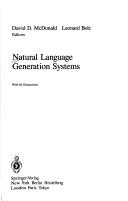
ISBN: 0387966919 3540966919 9783540966913 9780387966915 Year: 1988 Publisher: Berlin : Springer-Verlag,
Abstract | Keywords | Export | Availability | Bookmark
 Loading...
Loading...Choose an application
- Reference Manager
- EndNote
- RefWorks (Direct export to RefWorks)
Computational linguistics. --- Linguistique informatique --- Computational linguistics --- 681.3*I27 --- Automatic language processing --- Language and languages --- Language data processing --- Linguistics --- Natural language processing (Linguistics) --- Applied linguistics --- Cross-language information retrieval --- Mathematical linguistics --- Multilingual computing --- Natural language processing: language generation; language models; language parsing and understanding; machine translation; speech recognition and under-standing; text analysis (Artificial intelligence) --- Data processing --- 681.3*I27 Natural language processing: language generation; language models; language parsing and understanding; machine translation; speech recognition and under-standing; text analysis (Artificial intelligence)
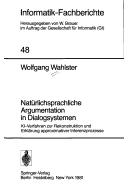
ISBN: 3540108734 0387108734 9780387108735 9783540108733 3662089254 Year: 1981 Publisher: Berlin Springer
Abstract | Keywords | Export | Availability | Bookmark
 Loading...
Loading...Choose an application
- Reference Manager
- EndNote
- RefWorks (Direct export to RefWorks)
#TCPW P7.2 --- #TCPW P7.6 --- #TCPW P9.0 --- 681.3*I27 --- Natural language processing: language generation; language models; language parsing and understanding; machine translation; speech recognition and under-standing; text analysis (Artificial intelligence) --- Question-answering systems. --- Artificial intelligence. --- Dialogsystem. --- Künstliche Intelligenz. --- Natürliche Sprache. --- Sprache. --- 681.3*I27 Natural language processing: language generation; language models; language parsing and understanding; machine translation; speech recognition and under-standing; text analysis (Artificial intelligence)

 Search
Search Feedback
Feedback About UniCat
About UniCat  Help
Help News
News